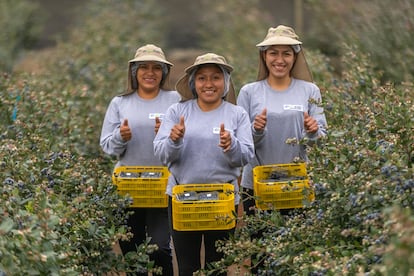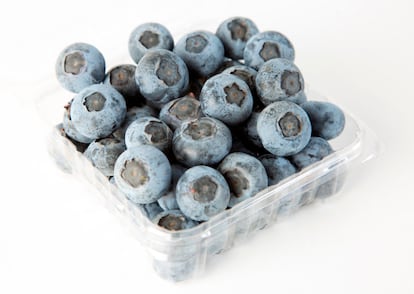How Peru became the king of blueberries
After being a minor competitor over the past decade, the South American country has leaped to become the main global exporter of these fruits

Peru has broken through in the world of forest fruits. The South American country has become the main exporter of blueberries on the planet, surpassing great powers such as the U.S., Canada and Chile. After being a minor competitor for the past decade, it has crowned itself the king of so-called “blue gold.”
The recipe for success has several ingredients: a perfect habitat (the coastal desert, with significant plots of land for large-scale production), the development of sophisticated irrigation systems (which have allowed for high productivity), science-based agriculture (with difficult research work in plant genetics) and a group of companies open to exploring new varieties to satisfy the market.
“Over the last decade, the blueberry industry has become truly global,” says Cindy van Rijswick, a fresh produce expert at Rabobank. “The international market is growing with the help of Peru.”
In 2022, the Andean country exported 287,806 tons of blueberries, worth about $1.4 billion. This figure represents a historical record — the fourth in a row for a national enterprise that, in 2012, didn’t sell any blueberries beyond its borders. One of the protagonists in this story is Carlos Gereda, the founder and executive director of Inka’s Berries.
After an important visit by Peruvian businessmen to Chile in 2002 — when blueberries already had a notable impact on international markets — Gereda, a graduate of La Molina Agrarian University, realized that, in his country, there was a general lack of knowledge about the product. From this, he drew two conclusions. First of all, the production of this fruit on Peruvian soil had great potential during the low season in the northern hemisphere — the region where the fruit is consumed in the greatest quantity. The United States — which, at the time, was the main supplier of blueberries in the world — supplied blueberries to the market between May and August. Afterwards, the season was partially over and consumers had to wait for Chile (which, until recently, was the leader in Latin America) to take over in December. In other words, between September and November, there weren’t enough blueberries on the market to meet growing demand. Argentina and Uruguay — also participants in the business — could barely cover the gap that opened up during that period.
This meant that there was a window of opportunity for Peru.

The second conclusion Gereda came to was that, in order to take advantage of the seasonal gap, it was necessary to have a plant that could be grown quickly and sold at a reasonable price. He got down to work, searching for a variety suitable for the conditions along the Peruvian coast. This wasn’t easy: blueberries require a cold period (known as a winter chill) to grow. At least 400 to 800 cold hours are needed at temperatures below a certain threshold, which is usually around seven degrees Celsius. This is something that cannot be achieved on the temperate Peruvian coast.
After a couple of years — and after testing 14 different varieties — Gereda hit the nail on the head with four of them. This led to the creation of protocols for in vitro propagation. The next challenge was to find agricultural companies willing to jump on the blueberry bandwagon in a land where grapes, asparagus and avocados have traditionally dominated the export market.
A key variety
This is how, in 2009, Gereda founded Inka’s Berries. That same year, Camposol — one of the largest agro producers in the country — decided to try out one of the varieties already tested by Gereda. Both companies found that the Biloxi variety was better adapted to local conditions. It was then that Camposol focused decisively on the development of this fruit. The company converted its asparagus fields — whose yields had been declining — into blueberry plantations. In 2011, they planted their first 50 hectares, and by 2016, they already had 1,600 hectares. Currently, Camposol — the largest exporter of blueberries in the country — has 3,000 hectares dedicated to the fruit.
“Something transformative and magical emerged in Peru,” says José Antonio Gómez, the CEO of the company. In 2022, his firm exported some 50,820 tons of blueberries. Last year, Camposol made almost $500 million, of which 65% is thanks to blueberries.
Currently, Peruvian farmers produce the fruit throughout the year, although the peak of production occurs between September and October. There are more than 20,000 hectares devoted to blueberries, which are sold in 30 nations. The country ranks third as a producer, after the US and China. In addition to Camposol, various companies also participate in the business, such as Agrovisión Perú, Hortifrut, Agrícola Cerro Prieto, or Exportadora Frutícola del Sur, among others. “We estimate that 135,000 direct jobs were generated in the last season,” says Luis Miguel Vegas, manager of ProArándanos.
As for the varieties, more than 65 different ones have been certified. Gereda — in collaboration with the University of Georgia — is developing new ones. “The blueberry is the last great agro-export product in the country, but it was preceded by asparagus, grapes and avocados,” explains Piero Ghezzi, founding partner of HacerPerú and a former Peruvian minister of production.
Ghezzi points out that the recent success is due to a confluence of factors. Firstly, because of the public policy decisions that the country has taken in recent decades. Among them, the development of irrigation projects along the Peruvian coast, the strengthening of Senasa — the health inspection entity in charge of opening new export markets — as well as the Agrarian Promotion Law. Passed in 2000, the legislation established a special tax and labor protocol, as well as free trade agreements signed with different markets, including the United States, China and the EU, which have allowed for duty-free exports.
The boom, however, is not without its risks. “The main one is farmers expanding production too fast,” Van Rijswick cautions. This could put pressure on margins and prices, which have already been on the decline in recent years. And then, there are other factors: competition from other countries, geopolitical tensions (such as the war in Ukraine, which has increased the costs of inputs), logistical difficulties, internal political unrest and the effects of climate change.
This last factor is already making a dent. A hotter climate affects some varieties of blueberries, making it difficult to know what the production levels of the 2023-2024 growing season will be. The manager of ProArándanos is prepared for all eventualities: “There are three possible scenarios: the first is that exports will grow, the second is that we will maintain last year’s numbers and the third is that we would see a drop in volume.” However, he notes, even if the latter occurs, “we would still maintain our position as the world’s leading exporter.”
Sign up for our weekly newsletter to get more English-language news coverage from EL PAÍS USA Edition
Tu suscripción se está usando en otro dispositivo
¿Quieres añadir otro usuario a tu suscripción?
Si continúas leyendo en este dispositivo, no se podrá leer en el otro.
FlechaTu suscripción se está usando en otro dispositivo y solo puedes acceder a EL PAÍS desde un dispositivo a la vez.
Si quieres compartir tu cuenta, cambia tu suscripción a la modalidad Premium, así podrás añadir otro usuario. Cada uno accederá con su propia cuenta de email, lo que os permitirá personalizar vuestra experiencia en EL PAÍS.
¿Tienes una suscripción de empresa? Accede aquí para contratar más cuentas.
En el caso de no saber quién está usando tu cuenta, te recomendamos cambiar tu contraseña aquí.
Si decides continuar compartiendo tu cuenta, este mensaje se mostrará en tu dispositivo y en el de la otra persona que está usando tu cuenta de forma indefinida, afectando a tu experiencia de lectura. Puedes consultar aquí los términos y condiciones de la suscripción digital.
More information
Archived In
Últimas noticias
There is as much life left to discover on planet Earth as that which is already known
Dozens presumed dead, around 100 injured in fire at Swiss Alps bar during New Year’s celebration
Is porn for women different from conventional porn? We spoke to those who make it
Cartagena de Indias is sinking: What can the city do to mitigate it?
Most viewed
- Reinhard Genzel, Nobel laureate in physics: ‘One-minute videos will never give you the truth’
- David King, chemist: ‘There are scientists studying how to cool the planet; nobody should stop these experiments from happening’
- Sinaloa Cartel war is taking its toll on Los Chapitos
- Oona Chaplin: ‘I told James Cameron that I was living in a treehouse and starting a permaculture project with a friend’
- The Interoceanic Train, the Mexican alternative to the Panama Canal











































